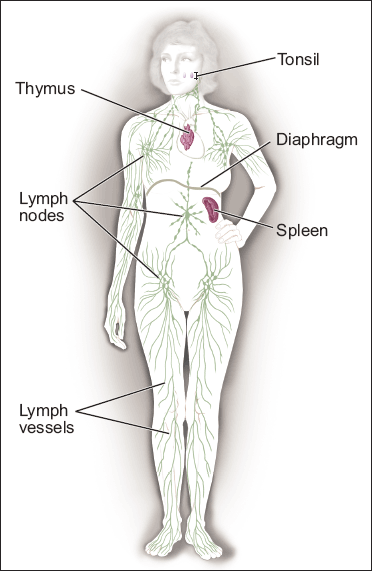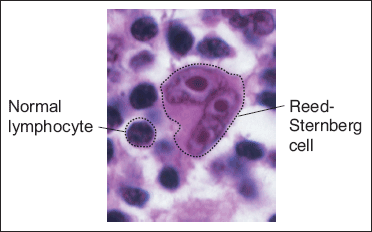|
What Is Hodgkin Lymphoma?
Hodgkin Lymphoma Cells
Hodgkin lymphoma is a cancer that begins in cells of the immune system. The immune system fights infections and other diseases.
The lymphatic system is part of the immune system. The lymphatic system includes the following:
- Lymph vessels: The lymphatic system has a network of lymph vessels. Lymph vessels branch into all the tissues of the body.
- Lymph: The lymph vessels carry clear fluid called lymph. Lymph contains white blood cells, especially lymphocytes such as B cells and T cells.
- Lymph nodes: Lymph vessels are connected to small, round masses of tissue called lymph nodes. Groups of lymph nodes are found in the neck, underarms, chest, abdomen, and groin. Lymph nodes store white blood cells. They trap and remove bacteria or other harmful substances that may be in the lymph.
- Other parts of the lymphatic system: Other parts of the lymphatic system include the tonsils, thymus, and spleen. Lymphatic tissue is also found in other parts of the body including the stomach, skin, and small intestine.
 |
| This picture shows lymph nodes above and below the
diaphragm. It also shows the lymph vessels, tonsils,
thymus, and spleen. |
Because lymphatic tissue is in many parts of the body, Hodgkin lymphoma can start almost anywhere. Usually, it's first found in a lymph node above the diaphragm, the thin muscle that separates the chest from the abdomen. But Hodgkin lymphoma also may be found in a group of lymph nodes. Sometimes it starts in other parts of the lymphatic system.
Hodgkin Lymphoma Cells
Hodgkin lymphoma begins when a lymphocyte (usually a B cell) becomes abnormal. The abnormal cell is called a Reed-Sternberg cell. (See photo below.)
The Reed-Sternberg cell divides to make copies of itself. The new cells divide again and again, making more and more abnormal cells. The abnormal cells don't die when they should. They don't protect the body from infections or other diseases. The buildup of extra cells often forms a mass of tissue called a growth or tumor.
See the Staging section for information about Hodgkin lymphoma that has spread.
 |
| Reed-Sternberg cells are much larger than normal
cells. |
< Previous Section | Next Section > |